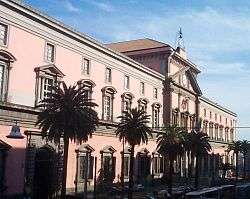List of museums in Naples

The Venus Kallipygos, in the Naples National Archaeological Museum.
The Italian city of Naples hosts a wealth of historical museums and some of the most important in the country. The Naples National Archaeological Museum is one of the main museums, considered one of the most important for artifacts of the Roman Empire in the world.[1] It also hosts many of the antiques unearthed at Pompeii and Herculaneum, as well as some artifacts from the Greek and Renaissance periods.[1]
List
This article consists of a brief list of museums in Naples:
| Name | Genre | Date | Description | Image |
|---|---|---|---|---|
| National Museum of Capodimonte | museum, art gallery (painting, sculpture, plastic arts, decorative arts) | first collections started in 1738, expanded 1787 | Found in the Palace of Capodimonte, it is arguably one of the city's most important art galleries and museums in the city of Naples. The first artistic collections go back to 1738, with the Bourbon King Charles VII of Sicily and Naples (who later became Charles III of Spain). As time went on, more and more art was collected, and finally, the gallery is currently a museum, which exhibits classical, Renaissance, Baroque and more modern art, sculptures, porcelain and majolica plates and decorations. |  |
| Naples National Archaeological Museum | classical (ancient Greek and Roman, mainly) artifacts | 1585, 1750s | Founded in 1585, it is an important archaeological museum, however, was established by Spanish and Neapolitan king Charles III in the mid-18th century. It contains classical sculptures and artifacts mainly collected in the archaeological sites of Pompeii and Herculaneum, which were discovered in the 1750s. |  |
| Secret Museum of Naples | private artifacts from Pompeii | 1819, closed in 1849, and re-opened in 1960 | Another museum in the city, it exposes explicit material found in Pompeii. It was closed down in 1849, yet re-opened in 1960. | ? (no available image) |
| National museum and monastery of San Martino | medieval and renaissance | Museum since 1866, building finished in 1368 | The museum is located in the former living quarters of the prior and the monks’ cells in the monastery complex Certosa di San Martino (St. Martin's Charterhouse) on the hill of Sant’Elmo on the Vomero. In over 70 halls, it displays exhibits from different eras of Naples’s city history. There are paintings and sculptures from the 13th to the 19th century as well as a folk art section, a marine- and a Vesuvius section, as well as a famous collection of Neapolitan nativity scenes. | |
| Zoological Museum of Naples | zoology, animals | 1813 | One of the city's principle museums with zoological collections, it was opened in 1813 by Joachim Murat. Later, the museum was ruined during World War II, yet, was restored from 1948 to 1970. | |
| Museo Civico Filangieri | plastic arts, applied arts | 1882 | Created by the prince Gaetano Filangieri the museum collects applied arts made by neapolitan artisans and artists, including paintings, wood sculptures, majolicas, porcelains, glasses, textiles, arms and armors, medals, and presepi (terracotta figurines of shepherds from Nativity Scene). | |
| Museo di Arte Contemporanea Donna Regina | contemporary art | 2007 | was born from a joint project by the Regione Campania, The Italian Ministry of Culture and European Community. It is located in the restored historical palace of Donnaregina and collects masterpieces of contemporary artists such as Andy Warhol, Alberto Burri, Lucio Fontana, Robert Mapplethorpe, Francesco Clemente, Jannis Kounellis, Giulio Paolini, Richard Serra, Jeff Koons, Richard Long, Rebecca Horn, Alfredo Pirucha, Domenico Paladino, Piero Manzoni. | |
| Palazzo Arti Napoli | Civic Museum and Exhibit Hall of the City of Naples Events | 2005 | The so-called "PAN" is one of the civic museum of Naples. It is located in the 16th-century Roccella Palace. It was born as a public exhibition center for the civic collections of arts, and to host art and culture events organized by the City of Naples. | |
| Città della Scienza | science museum | 1996 | The Museum of Science of Naples, called "Città della Scienza" was created by a consortium of public and private investors called "Fondazione IDIS". It is located in Bagnoli, in one of dismissed areas of steelworks foundry industry. Its original nucleus was built into 19th-century workshops, examples of industrial archeology. It is aimed at transmitting science culture mainly to a public of students and young people, and to testimony examples of sustainable technologies. It was burnt in an arson, march 4, 2013 and actually it is under reconstruction. The exploratorium area for kids has been rebuilt and it is actually open to visits. |
References
This article is issued from Wikipedia - version of the Tuesday, March 17, 2015. The text is available under the Creative Commons Attribution/Share Alike but additional terms may apply for the media files.